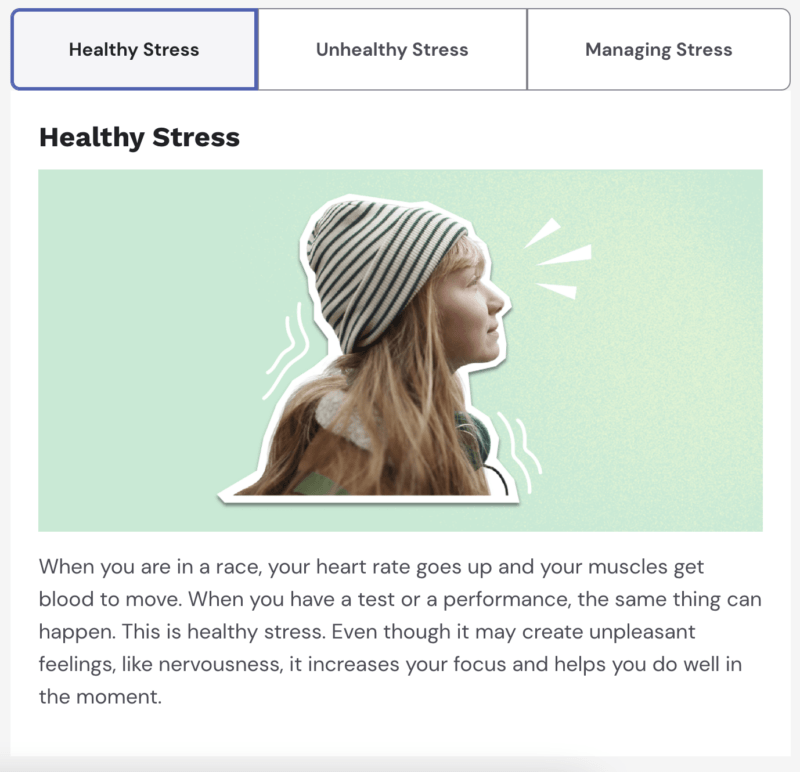

How Two Teachers Are Supporting Teens’ Mental Health Right Now
If you teach middle or high school, chances are you’ve had at least one student that you’ve been concerned about this year—the kind of kid that you pull aside after class to talk about what’s going on.
As teachers, our own mental health has suffered since the pandemic and the resulting stress and teacher shortages. It’s no surprise that many of our students are struggling too.
“Obviously, the pandemic has shone a spotlight on mental health,” says Erin McClintock, former EVERFI Vice President of Community Engagement, Impact, and Education. “Even before the pandemic, we had what many would consider a mental health crisis, and it has only been exacerbated.”
Mental wellness matters.
There is a growing need for mental health support for youth. From anxiety to depression—which can be compounded by issues like bullying, trauma, and lack of access to basic needs—20% of children and adolescents will experience a mental health concern during their school years.
This year, that need is even more pressing. The effects of the pandemic are still lingering, especially for youths who missed out on formative experiences, alongside social isolation. A recent 2023 survey found that over 16% of teens ages 12 to 17 “reported suffering from at least one major depressive episode (MDE) in the past year.”
“Some students are doing well,” says McClintock, “but for others, it’s been a real problem.” Now that we’re seeing the impact of the pandemic, how can we strengthen students’ mental health and resilience? We talked with two teachers who already emphasized mental health in their classrooms about what they’re doing about it.
Make mental health part of the daily check-in.
“Teachers are in an important position to support teens’ mental health,” says McClintock. It can be as simple as helping students see the connection between their mental health and academics.
At Ohio Virtual Academy, eighth grade math teacher Kimberly Palocsay uses EVERFI’s free online curriculum Understanding Mental Wellness to check in with her students and give them the language they need to discuss mental health. The curriculum consists of six self-paced activities that take about 15 minutes each. Palocsay uses the program’s framework as a tool for talking about mental health for an entire semester. And she predicts her students will use it long after too. It’s a program you can trust, having recently been awarded the ISTE Seal and Digital Promise Product certification, indicating the lessons are high-quality and research-based.
After completing the Understanding Mental Wellness curriculum, Palocsay says her students are able to think more critically about their feelings and actions. The curriculum gives her vocabulary to use when checking in with her students. “Once kids can name something, it becomes easier to understand and relate to,” Palocsay says. “And for mental health, this can be a really important way to reduce stigma.”
Start with self-awareness.
According to the Collaborative for Academic, Social, and Emotional Learning (CASEL), self-awareness is one of the core social-emotional competencies that students need in order to succeed. Self-awareness is critical for students to recognize when they’re struggling as well as identify the tools necessary to get through it. After completing Understanding Mental Wellness, Palocsay noticed her students were quicker to name their own feelings and experiences. From there, she was able to help them enhance their self-awareness by talking through the impact of their actions and decisions on their overall well-being. For example, if they didn’t get enough sleep the night before, they might feel grumpy and snap at a friend.
Perspective-taking is another critical skill.
Understanding Mental Wellness also helped Palocsay talk about perspective-taking, an important social-awareness competency. Teenagers can find it difficult to understand that others have the same feelings and responses they do. Just the awareness that others are going through the same thing—for instance, that parents may also be facing stressors—is helpful. “That was the biggest thing (my students) came back to me with. They started having awareness of why their parents or others did what they did,” she shared.
Teens can—and will—develop self-care strategies that work for them.
Even though her students have completed the program, Palocsay continues to embed the lessons learned from Understanding Mental Wellness. She regularly encourages her students to talk about how their schedules and technology impact them and how they plan their days to get enough food and sleep. When students figure out how to use even simple strategies, like setting a reminder to go to bed on time, it has a ripple effect.
These lessons help students practice mindfulness and stay present. For example, when a student in Palocsay’s class said he was too anxious to think about math, she encouraged him to try to let math take up the space he was using for worrying for a few minutes. This year, make coping strategies an everyday thing by posting the strategies in a place where students can access them, whether it’s your online learning platform or in students’ daily agenda. That keeps the language consistent and reminds students that they have skills they can use to feel better.
Starting a conversation about mental health can empower students now and in the future.
Giving students a way to talk about mental wellness can help bring it into everyday discussions. Tracy Bonebrake-Miller, a 10th grade teacher at Waynesboro High School in Pennsylvania, used Understanding Mental Wellness both online during the height of the pandemic and in person. She finds the content to be more relevant than ever. In Bonebrake-Miller’s class, students process what they learned online through class discussions. The hope is that talking about mental wellness at school will spill over into the home.
“Kids likely may not talk about traditional academics over the dinner table,” says Palocsay, “but they may share what they learned and thought about in Understanding Mental Wellness and how it relates to them.” Even after the effects of the pandemic have subsided, students will need to have a bank of mental-wellness skills. The goal of starting with this online program is to ultimately give students a way to think and talk about mental wellness so they can build strategies to use now and in the future.
In Understanding Mental Wellness, a new lesson on “Creating a Supportive Mental Health Plan” teaches students to understand how mental health impacts them and others. By helping students think beyond the present moment, we can help them use the skills and strategies they’re learning throughout their lives to formulate a plan.

Students will leave this course with self-help strategies and an improved understanding of how to identify and minimize risks for worsening mental health while feeling empowered to act as an advocate for themselves and others.
Thanks to our friends at EVERFI for sponsoring this post. Learn more about their free digital resources for social-emotional learning, like the Understanding Mental Wellness curriculum.

Dig Deeper With Our Longreads
Newsletter Sign up to get our best longform features, investigations, and thought-provoking essays, in your inbox every Sunday.
The MEN was founded by John Huber in the fall of 2020. It was founded to provide a platform for expert opinion and commentary on current issues that directly or indirectly affect education. All opinions are valued and accepted providing they are expressed in a professional manner. The Maryland Education Network consists of Blogs, Videos, and other interaction among the K-12 community.








